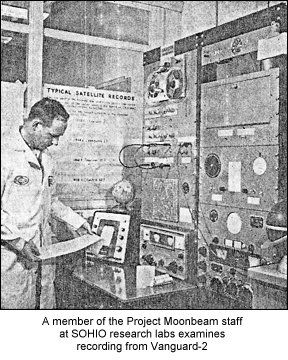Space Cover #394: Standard Oil – Satellite Tracking?At the Standard Oil (Ohio) SOHIO Research Laboratory, in Warrensville Heights, Ohio the staff operated a satellite tracking station as an extra-curricular activity and called it Project Moonbeam. It was called the best homemade satellite tracking station in the world by Popular Science magazine.
Using regular ham radio gear they made such accurate measurements that hundreds of newspapers and broadcasting stations used them to get first reliable reports of US and Russian space shots. The SOHIO Satellite Tracking Station (SSTS) was the first to determine the orbits of Echo I, Explorer VIII, and Courier I. Its predictions for sightings of Echo I and II were published by over 150 newspapers in Ohio and Pennsylvania. SSTS was also credited with developing a method of determining weights and orbits of satellites from a single station.
The station was supplied with do-it-yourself gear such as two VHF receivers, a few frequency converters, and a few pen and tape recorders and graph makers.
As Earth orbiting satellites were soon to become reality, Ralph Burhans first came up with the idea of tracking satellites with his home ham radio equipment but then thought about who would track the satellites while he was at work. So he approached his employer, Standard Oil, with the idea of using some unused space in its research facility. His boss, Dr. A. L. Jones took the idea to the management team where nothing happened for a year – then came Sputnik. Burhans brought in a recording he made of the satellite and that excitement freed up the idea and it was approved shortly after. The station was built and operational in time for Explorer I. Beyond just tracking, SSTS was also able to record Ranger VII moon photos.
The satellite trackers at SOHIO used radio interferometer methods to track early U.S. satellites on 108 MHz. Two Yagi antennas were mounted on an east-west line. The director of the tracking station during the period 1958-1964 was Dr A.L. Jones. He was succeeded by Robert Thompson, who ran the station from 1964 until it ceased operations in May 1965.
In addition to tracking US satellites there were also Russian satellites and manned missions. In 1963 Dr. A.L. Jones and his associates at the SOHIO Research Laboratory in Cleveland received the Aviation Week and Space Technology Laureates Award for achievements in operating a private satellite tracking station which provides so much valid data on Soviet space flights.
Mr. Thompson told Popular Mechanics that the station tracked all of the Vostoks and Voskhods on shortwaves including Titov talking with his tracking ship. Other write-ups on the SSTS described tracking of:
- Vostok 3 and 4
- Vostok 5 and 6
- Voice from Voskhod 2 on 18.035 MHz on rev 6 and 7 and short-wave telemetry (19.996 MHz) on revs 4, 5, 6, 7, 12.
- FSK-PDM telemetry signals on 19.945 MHz from Polyot 1 on revolution 3, 4, 5, 11,12, and 13
- Soviet Kosmos satellites on 90 MHz.
The SSTS eventually acquired a steerable 28-foot dish antenna that was donated to the Ohio University Radar Hill Laboratory, operated in the 1960s and 70s by the Avionics Research Group of the Department of Electrical Engineering. 
This is a picture of a member of Project Moonbeam looking at a recording of Vanguard II data.
The Gemini 3 cover depicted above is how I found out about this group of individuals that were also to come together using do-it-yourself equipment to do amazing things. Though it actually did not track Gemini 3 because of the orbital trajectory this cover is a commemorative tribute to this team. So keep looking, there are a lot of other unknown stories out there to find...













